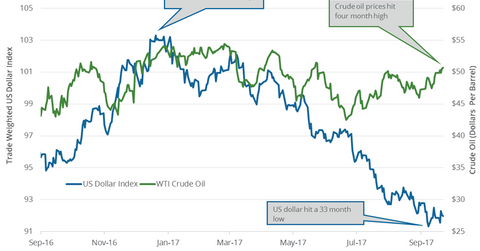US Dollar Could Help Crude Oil Futures
The US Dollar Index fell 0.1% to 91.97 on September 22, 2017. However, the US dollar rose 0.7% on September 20, 2017, after the FOMC’s meeting.
Sept. 25 2017, Published 10:26 a.m. ET

US dollar’s drivers last week
The US Dollar Index fell 0.1% to 91.97 on September 22, 2017. However, the US dollar rose 0.7% on September 20, 2017, after the FOMC’s meeting. On September 20, 2017, the Fed left US interest rates unchanged. The Fed also hinted that it might hike interest rates for the third time this year in December 2017.
Meanwhile, the US dollar (UUP) is near a 33-month low. The US dollar’s bearish drivers are discussed below.
- There was a surprise fall in US retail sales in August due to Hurricane Harvey.
- There’s geopolitical tension between North Korea and the US.
- The euro is near a 30-month high.
US dollar’s performance
The US dollar has fallen ~12% year-to-date. President Trump’s inability to deliver on proposed tax cuts and infrastructure spending weighed on the US dollar.
If President Trump succeeds in proposed tax cuts and infrastructure spending, there would be increased economic activity and improved inflation. As a result, it would increase the speed at which the Fed increases the interest rate.
Relationship between the US dollar and crude oil
The US dollar and crude oil (UWT) (DWT) prices tend to be inversely related. A weak US dollar makes crude oil economical for crude oil importers. As a result, it supports crude oil prices. Similarly, a strong dollar can pressure crude oil prices.
Impact
Expectations of a weak dollar could support crude oil (USO) (UCO) prices. Higher crude oil prices have a positive impact on oil producers (XLE) (XOP) like Chevron (CVX), PDC Energy (PDCE), ConocoPhillips (COP), and Sanchez Energy (SN).
In the next part of this series, we’ll analyze crude oil price drivers in the last 18 months.
